|
|
 |
Fiche d'espèce de Copépode |
|
|
Monstrilloida ( Ordre ) |
|
|
|
Monstrillidae ( Famille ) |
|
|
|
Monstrilla ( Genre ) |
|
|
| |
Monstrilla longicornis Thompson, 1890 (F,M) | |
| | | | | | | Syn.: | Monstrilla intermedia Aurivillius, 1898 (after Sars, 1921 a, p.12)
Monstrilla clavata Sars, 1921 a (p.14, figs.F); Rose, 1933 a (p.341, figs.F); C.B. Wilson, 1950 (p.267); ?Harvey J.B.J. & al., 2012 (p.60, Table 2, molecular sequences) | | | | Ref.: | | | T. Scott, 1904 (p.244, figs.F,M); Pearson, 1906 (p.33); van Breemen, 1908 a (p.204, figs.F, M); Farran, 1908 b (p.91); A. Scott, 1909 (p.235, figs.F); Pesta, 1920 (p.635, fig.F); Sars, 1921 a (p.11, figs.F,M); Sewell, 1949 (p.132, 141); Isaac, 1975 (p.3, 6, 7, figs.F,M); McAlice, 1982 (p.46); Huys & Boxshall, 1991 (p.155, 156, 464, figs.F,M); Grygier, 1994 (p.240: Rem.); 1995 a (p.37, 69); Suarez-Morales, 2000 b (p.685: Rem.); Boxshall & Halsey, 2004 (p.836, figs.F,M); Vives & Shmeleva, 2010 (p.180, figs.F,M, Rem.) | 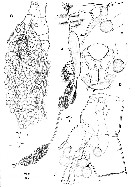 issued from : R. Huys & G.A. Boxshall in Copepod Evolution, The Ray Society, 1991. [p.161, Fig.2.5.4]. Female (from Norway): A, habitus with two egg masses (lateral); B, urosome with eggs (lateral); C, 5th pedigerous and genital double somites (lateral); D, structures associated with genital aperture (ventral view); E, idem (lateral view). Arrows show copulotary pore in C-E.
|
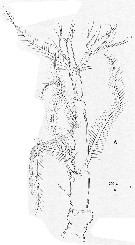 issued from : R. Huys & G.A. Boxshall in Copepod Evolution, The Ray Society, 1991. [p.162, Fig.2.5.5]. Male (from Norway): A, A1.
|
 issued from : R. Huys & G.A. Boxshall in Copepod Evolution, The Ray Society, 1991. [p.164, Fig.2.5.7]. Male (from Norway): D, urosome (lateral); E, idem (ventral).
|
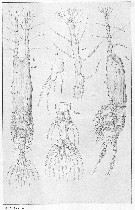 issued from : G.O. Sars in An Account of the Crustacea of Norway, with short descriptions and figures of all the species, 1921 a, 8. [Pl. II]. Female (from South & West coast of Norway). Urs, urosome (ventral). Nota: Body integuments exhibit everywhere a finely granular or dotted surface. Cephalic segment occupying about half the length of the body. Eye imperfectly developed, without any trace of refracting elements, and only replaced by a diffuse yellowish pigment. A1 apparently 5-segmented, only the 1st distinctly defined, the others being confluent and only indicated by slight constrictions of the antenna; most of the setae attached around the middle of the fusiform terminal segment reachly ramified. Oral tubule well marked and occurring somewhat behind the middle of the cephalic segment. natatory legs all of the very same structure and of about equal size; 2nd basal segment (Basis) not very sharply defined from the 2st basal segment (Coxa) and armed inside with 2 small juxtaposed denticles; terminal segment (exopod) having the outer edge divided into 4 very distinctly marked crenulations. Last pair of legs rather broad at the base, but having the outer part abruptly narrowed and provided at the obtusely rounded extremity with 3 ciliated setae, the innermost of which is much smaller than the other 2; inner expansion almost rectangular and carrying a single, but well developed seta. Genital segment being fully as long as the remaining part of the urosome, and oblong quadrangular in shape, with a well marked transverse suture in the middle of the dorsal face; ovigerous spines about twice the length of the urosome. Caudal rami about equalling in length the last 2 segments combined and slightly divergent, each provided with 5 strong plumose setae of nearly equal size, the outmost one attached to a well-marked ledge of the outer edge. The movements of the animal are very rapid, and are performed in abrupt bounds, whereby the body is kept in a more or less erect position. Male specimens seem to occur in nearly same number as the females. Body in both sexes of a yellowish grey colour.
|
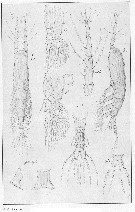 issued from : G.O. Sars in An Account of the Crustacea of Norway, with short descriptions and figures of all the species, 1921 a, 8. [Pl. III]. Male (from South and West coast of Norway). Nota: Considerably smaller than female and of somewhat shorter and stouter form. A1 more strongly built than in female and having the segments more distinctly defined, being more over conspicuously hinged, the hinge located between the last 2 segments. Natatory legs of same structure as in female. Last pair of legs much reduced in size, forming 2 small knob-like prominences issuing from a common base, each prominence tipped by 2 (in some cases only 1) slender setae. Urosome comparatively more slender than in female, and composed of 4 well defined segments of nearly equal length, the 1st produced below to a club-like copulative appendage terminating in 2 short diverging rami, each armed at the end with a short spine. Caudal rami of a similar shape to that in female, but with one of the apical setae absent.
|
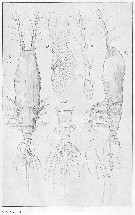 issued from : G.O. Sars in An Account of the Crustacea of Norway, with short descriptions and figures of all the species, 1921 a, 8. [Pl. VI]. As Monstrilla clavata. Female (from Hvalør, outside the Christiana Fjord). Nota : Body rather stout and clumsy, considerably dilated in its anterior part and viewed laterally, of a pronouncedly clavate shape. Cephalic segment very large, occupying rather more than half the length of the body, and having its greatest width about in the middle, dorsal face remarkably vaulted in front. Eye inconspicuous. A1 not nearly attaining the length of the cephalic segment. Oral tubule rather prominent and occurring somewhat behind the middle of the cephalic segment. Tail about half the length of the exposed part of the trunk. Ovigerous spines rather produced, being fully 3 times as long as the tail. Caudal rami exceeding somewhat in length the last 2 segments combined, and only slightly divergent, each provided with 5 setae, the innermost but one being considerably shorter than the others. natatory legs, as in M. longiremis, armed inside the 2nd basal segment with a single well-marked denticle, terminal segment of outer ramus with a slight indication of a crenulation of the outer edge. last pair of legs very similar in shape to those in M. longicornis, the inner expansion being rather prominent.
|
 Issued from : A. Scott in The Copepoda of the Siboga Expedition Part I. Siboga-Expeditie XXIX a., 1909. [Pl. LVII, Figs.3-4]. Female (from 1°33' N, 124°47'.5 E): 3,habitus (dorsal); 4, P5. Nota: A1 2-segmented, equal to two-thirds of the length of the cephalic segment.Abdomen 3-segmented. Genital segment sub-quadrangular in shape and equal to nearly twice the combined length of the next two segments. It is considerably shorter than the united length of the next two segments and caudal rami. The segment is marked by a well defined suture traversing the middle. The 3rd segment very short and equal to about half the length of the 2nd segment. Caudal rami 4 times longer than the anal segment, each ramus with 1 outer marginal seta and 4 apical setae. The 2nd inner seta shorter than the others. P5 sub-cylindrical in shape with a distinct contraction in the middle. Each foot is furnished with 1 inner marginal seta and 2 apical setae. The only difference between the Siboga's specimens and the illustrations given by Giesbrecht (1893) and by T. Scott (1904), is the absence of a 3rd seta on the apex of P5.
|
 Issued from : T. Scott in Rep. Fishery Bd Scotl., 1904, 12 (3). [Pl. XIII, fig.1]. Female (from Scotland): 1, habitus (dorsal). Nota: It may be remarked that the integument is seen to have a granular appearance
|
 Issued from : T. Scott in Rep. Fishery Bd Scotl., 1904, 12 (3). [Pl. XIII, figs.3, 4, 5]. Female: 3, A1; 4, P5; 5, abdomen and caudal rami. Nota : A1 elongated anf slender, being in some examples nearly ½ as long as the cephalothorax and abdomen combined ; but their length seems to vary to some extent in different individuals ; all the segments except the first appear to be coalescent, so that each A1 is apparently 2-segmented. P5 consist each of a sub-cylindrical plate, but the proximal half of the le gis rather’ wider than the lower half an dis defined from it by a distinct notch on the inner margin, and from this notch there springs a moderately long seta ; 3 other setae spring from the distal extremity of the leg, but the innermost one is short while the other two are elongated ; all the setae appear to be more or less plumose. Caudal rami each furnished with 5 moderately long setae.
|
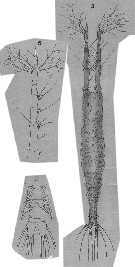 Issued from : T. Scott in Rep. Fishery Bd Scotl., 1904, 12 (3). [Pl. XIII, figs.2, 6, 7]. Male: 2, habitus (dorsal); 6, A1; 7, Abdomen and caudal rami (ventral). Nota : A1 as in those of the females, but appear to be proportionally rather longer than in the female. Composed of 6-segments, and the articulation between the 5th and 6th is so hinged that the 6th segment can be folded inwards ; the 2nd and last segments are of nearly equal length anf considerably longer than any of the others. P5 somewhat rudimentary, each being represented by a single moderately long plumose seta which springs from a small tubercle near the lower ventral margin of the last thoracic segment. The genital appendages are narrow and spiniform. caudal rami each with only 4 setae.
| | | | | Ref. compl.: | | | Pearson, 1906 (p.33); Vaissière & Séguin, 1980 (p.23, tab.1); Buchanan & Sekerak, 1982 (p.41, Rem.: p.49); Falkenhaug & al., 1997 (p.449, spatio-temporal pattern); Holmes, 2001 (p.62); Bernier & al., 2002 (p.651, tab.1); Dvoretsky & Dvoretsky, 2010 (p.991, Table 2) | | | | NZ: | 7 + 1 douteuse | | |
|
Carte de distribution de Monstrilla longicornis par zones géographiques
|
| | | | | | | | | | | | | Loc: | | | G. of Maine, ? W Baffin Bay, Puffin Is., W Ireland, Man Is., Firth of Forth, Firth of Clyde, S & W Norway, Malangen fjord, Barents Sea, North Sea (GB), English Channel, W Mediterranean Sea (Algiers, Tyrrhenian Sea), India, Indonesia-Malaysia, Philippines, Viet-Nam, ? Monterey Bay. | | | | N: | 18 | | | | Lg.: | | | (5) F: 2,8; (449) F: 3,1-3; M: 2; (663) F: 4,5; (727) F: 3,1; M: 2; (748) F: 4; 3,7; M: 2,7; {F: 2,80-4,50; M: 2,00-2,70} | | | | Rem.: | For Sars (1921 a, p.12) this species may be easily distinguished from its nearest allies by the somewhat robust body and the rather coarse and distinctly granular integuments and the structure of the natatory legs by the presence inside the 2nd basal segment of 2 well defined denticles, and the very conspicuous crenulation of the outer edge on the terminal segment of the exopod. These characters are pretty constant and found quite alike in both sexes. | | | Dernière mise à jour : 09/05/2016 | |
|
|
 Toute utilisation de ce site pour une publication sera mentionnée avec la référence suivante : Toute utilisation de ce site pour une publication sera mentionnée avec la référence suivante :
Razouls C., Desreumaux N., Kouwenberg J. et de Bovée F., 2005-2025. - Biodiversité des Copépodes planctoniques marins (morphologie, répartition géographique et données biologiques). Sorbonne Université, CNRS. Disponible sur http://copepodes.obs-banyuls.fr [Accédé le 26 décembre 2025] © copyright 2005-2025 Sorbonne Université, CNRS
|
|
 |
 |













